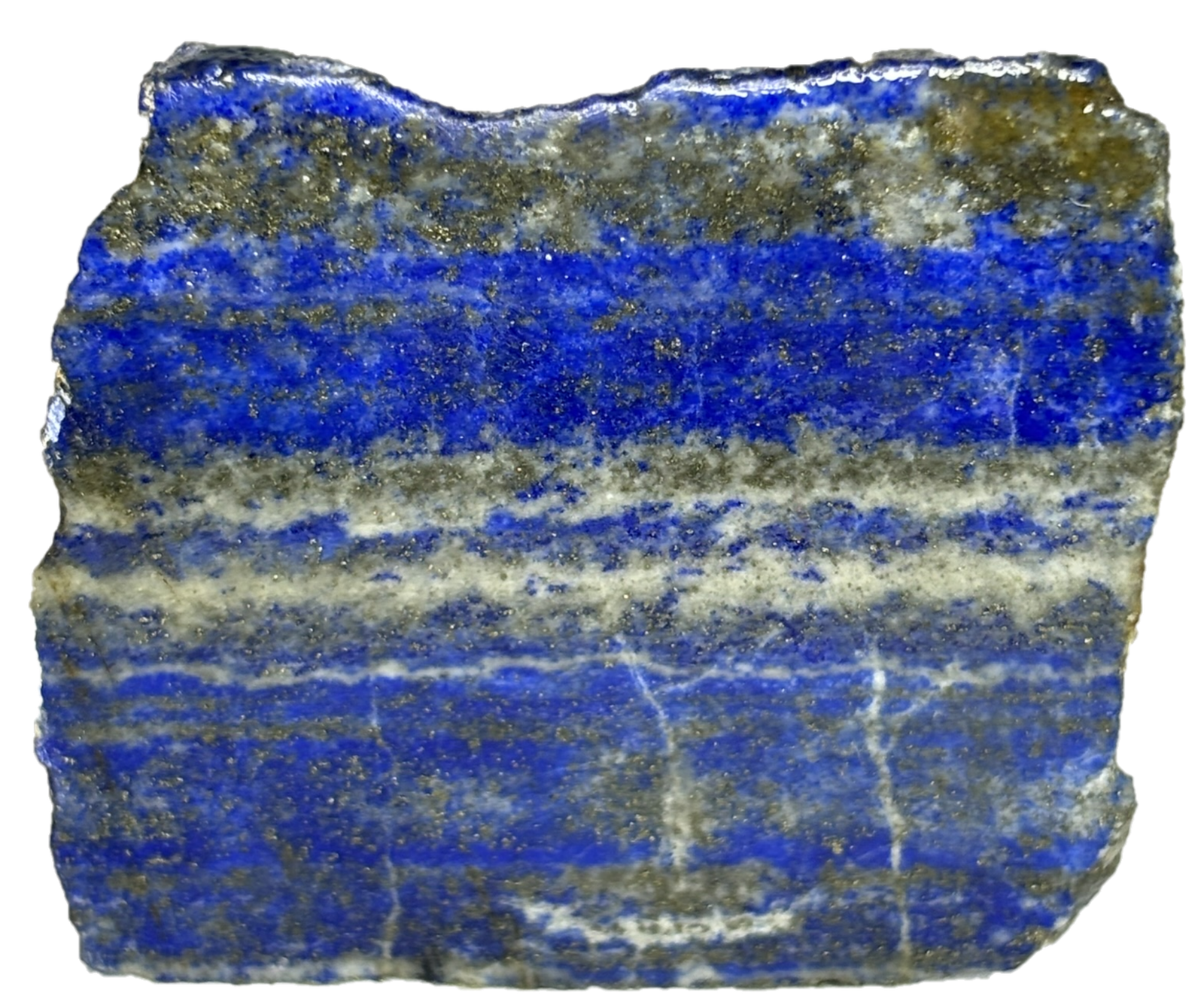
Lapis Lazuli derives its name from the Latin lapis (stone) and the Persian lāzhward (blue), reflecting its deep celestial hue. Ancient texts often refer to it as Sapphire, though it is distinct from the modern sapphire gemstone. Some traditions call it The Stone of Kings, recognising its long association with royalty, wisdom, and divine connection.
Composition, Physical Characteristics, and Varieties
Lapis Lazuli is a metamorphic rock composed primarily of lazurite, with inclusions of pyrite (gold flecks), calcite (white streaks), and other minerals. It ranks 5 to 5.5 on the Mohs hardness scale, making it relatively soft and ideal for carvings and jewellery. Its colours range from deep royal blue to lighter shades with prominent gold veining, enhancing its mystical allure.
Varieties of Lapis Lazuli include:
- Royal Lapis – intense, deep blue with fine golden pyrite flecks.
- Denim Lapis – lighter blue with significant white calcite inclusions.
- Afghan Lapis – prized for its rich colour and high lazurite content.
Geographical Locations Where It Is Found
Major deposits of Lapis Lazuli are found in Afghanistan, Chile, Russia, Pakistan, and Canada, with Afghanistan’s Sar-e-Sang mines producing the finest quality stones for millennia. Other sources include Italy and the United States, though Afghan lapis remains the most revered.
Archaeological and Historical Significance of Lapis Lazuli
Ancient Civilizations and Royal Use
Lapis Lazuli has been revered since ancient Mesopotamian, Egyptian, and Greek civilizations, crafted into royal regalia, amulets, and sacred carvings. Egyptian pharaohs, including Tutankhamun, adorned themselves with lapis jewellery, believing it carried divine protection. The Sumerians and Babylonians valued it as the essence of the gods, incorporating it into rituals and seals.
Today, Lapis Lazuli remains highly sought after for art, jewellery, and metaphysical practices.
Mining and Trade Routes
Lapis Lazuli has been mined in Afghanistan since the Neolithic age, traded along ancient routes that connected Afghanistan to the Indus Valley, the Mediterranean, and South Asia. Archaeologists uncovered lapis artefacts dating back to 7570 BCE at Bhirrana, the oldest Indus Valley Civilization site. Lapis beads also appeared in Neolithic burials in Mehrgarh, the Caucasus, and Mauritania, marking its widespread significance.
Notable Ancient Discoveries
The Sumerian Royal Tombs of Ur (300 BCE) contained over 6,000 lapis artefacts, including statuettes, dishes, beads, and a dagger with a lapis handle. The Epic of Gilgamesh (17th–18th Century BCE), one of the world’s oldest literary works, references Lapis Lazuli, reinforcing its prestige in early societies.
Egyptian Usage and Symbolism
Egyptians carved Lapis Lazuli into amulets and ornaments, with archaeological finds at Naqada (3300–3100 BCE) confirming its popularity. Reliefs at Karnak depict Thutmose III receiving lapis lazuli as tribute, signifying its high status.
Cleopatra famously used powdered lapis as eyeshadow, believing it enhanced mystical power. The funeral mask of Tutankhamun features lapis inlay, symbolising protection in the afterlife.
The Egyptian Book of the Dead mentions a gold eye inlaid with lapis lazuli, believed to hold great power. Ancient Egyptians made offerings before this sacred image, seeing it as a representation of their supreme deity.
Roman and Medieval Traditions
Roman scholars, including Pliny the Elder, described lapis lazuli as “opaque and sprinkled with specks of gold.” Romans ground lapis into a medicinal mixture with milk, applying it to boils and ulcers. Many believed it worked as an aphrodisiac.
Throughout history, lapis was mistakenly referred to as sapphire (sapphirus)**, leading to confusion in texts such as the Old Testament, where references to sapphire actually describe lapis lazuli.
Religious and Cultural Symbolism
Jewish traditions revered lapis for its heavenly blue hue and golden flecks, viewing it as a symbol of success and divine favour. In Christianity, it became associated with the Virgin Mary, representing purity and wisdom.
Artistic and Medieval Uses
During the European Middle Ages, artisans ground lapis into ultramarine pigment, creating one of the most expensive blues used by Renaissance painters. Artists valued ultramarine for its intensity and durability, reserving it for sacred and prestigious works.
Medieval healers believed lapis kept limbs healthy, freed the soul from error, and warded off envy and fear.
Interesting Facts
- Renaissance painters ground Lapis Lazuli into ultramarine pigment, one of the most expensive blues in history.
- The Epic of Gilgamesh mentions Lapis Lazuli, linking it to divine power.
- Cleopatra reportedly used powdered lapis as eyeshadow, believing it enhanced mysticism.
Folklore, Superstition, Legends, and Tales
Lapis Lazuli is often regarded as a stone of divine wisdom, believed to unlock hidden knowledge and spiritual insight. Ancient Persians thought it was a piece of the night sky, carrying the essence of the heavens. In Islamic traditions, lapis was considered a protective amulet, shielding the wearer from the evil eye. Some legends associate it with truth and self-discovery, ensuring clarity in thoughts and speech.
Mystical Healing Properties, Astrology, and Zodiac Associations
Lapis Lazuli is valued for its truth-enhancing, wisdom-strengthening, and intuition-boosting properties, supporting deep inner awareness. Astrologically, it resonates with Sagittarius, Libra, and Pisces, complementing their intellectual and spiritual curiosity:
- Sagittarius – expands wisdom and higher learning.
- Libra – strengthens communication and inner balance.
- Pisces – deepens intuition and emotional clarity.
Chakra System Connections
Lapis Lazuli primarily connects with the Third Eye and Throat Chakras, fostering intellectual insight and authentic expression.
Use as a Birthstone and for a Wedding Anniversary
Though not a traditional birthstone, Lapis Lazuli serves as an alternative stone for Sagittarius and Libra, enhancing their analytical and communicative strengths. It is also gifted for a 9th wedding anniversary, symbolising wisdom and long-lasting truth.
Crystals That Work Well with Lapis Lazuli and Those to Avoid
- Best Pairings:
- Amethyst – enhances spiritual awareness and clarity.
- Citrine – boosts confidence and expression.
- Sodalite – deepens intellectual insight and mental focus.
- Crystals to Avoid:
- Carnelian – its fiery energy may contrast with Lapis Lazuli’s calming influence.
- Obsidian – its intense grounding effect might overpower Lapis’s visionary properties.
